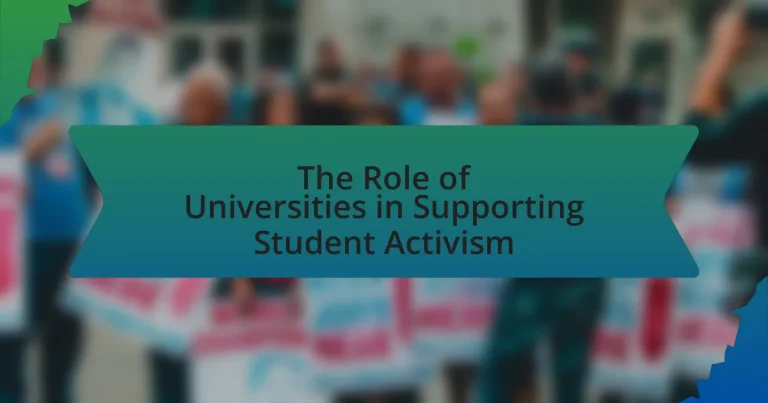The article examines the critical role of universities in supporting student activism, highlighting how these institutions provide platforms for expression, resources, and policies that protect students’ rights to engage in social change. It discusses the definitions of university roles in activism, the implementation of supportive policies, and the perceptions of university administrations regarding student movements. Additionally, the article explores the historical context of student activism, its importance in fostering civic engagement, and the challenges universities face in balancing institutional authority with student rights. It also outlines best practices for enhancing support for activism, including partnerships with community organizations and the provision of training and resources for students.

What is the Role of Universities in Supporting Student Activism?
Universities play a crucial role in supporting student activism by providing a platform for students to express their views, engage in dialogue, and mobilize for social change. They facilitate this through resources such as student organizations, funding for events, and access to faculty mentorship, which empowers students to organize and advocate for various causes. For instance, many universities have established policies that protect students’ rights to free speech and assembly, fostering an environment where activism can thrive. Additionally, research indicates that campuses with active student organizations report higher levels of civic engagement among students, demonstrating the positive impact of university support on activism.
How do universities define their role in student activism?
Universities define their role in student activism as facilitators of dialogue and platforms for expression. They recognize the importance of supporting students’ rights to engage in activism as part of their educational experience. This support often includes providing resources such as meeting spaces, funding for events, and guidance on organizing activities. For instance, many universities have established policies that protect students’ freedom of speech and assembly, reflecting a commitment to fostering an environment where diverse viewpoints can be expressed. Additionally, research indicates that institutions that actively engage with student activism can enhance civic engagement and critical thinking skills among students, further validating their supportive role.
What policies do universities implement to support student activism?
Universities implement various policies to support student activism, including freedom of speech protections, funding for student organizations, and guidelines for peaceful protests. These policies ensure that students can express their views and engage in activism without fear of retribution. For instance, many universities have established free speech policies that explicitly protect students’ rights to assemble and voice their opinions on campus. Additionally, universities often allocate budgets for student-led initiatives and events, which can include workshops, rallies, and awareness campaigns. Furthermore, institutions may provide resources such as training on advocacy and organizing skills, which empower students to effectively engage in activism. These measures collectively foster an environment conducive to student activism, reflecting the universities’ commitment to supporting civic engagement and social change.
How do university administrations perceive student activism?
University administrations often perceive student activism as a double-edged sword, recognizing its potential to foster social change while also viewing it as a challenge to institutional authority. Administrators acknowledge that student activism can enhance campus dialogue and promote civic engagement, as evidenced by initiatives that have emerged from student-led movements, such as the civil rights movement and environmental advocacy. However, they may also express concern over disruptions to campus operations and the potential for conflict, particularly when activism involves protests or demands for policy changes. This perception is shaped by historical instances where student activism has led to significant institutional reforms, such as the establishment of diversity programs and changes in governance structures, highlighting both the positive impact and the complexities involved in managing student activism within the university setting.
Why is student activism important in the university context?
Student activism is important in the university context because it fosters critical thinking, civic engagement, and social change among students. Universities serve as incubators for ideas and movements, allowing students to challenge injustices and advocate for reforms. Historical examples, such as the Civil Rights Movement and anti-Vietnam War protests, illustrate how student activism has led to significant societal shifts and policy changes. Furthermore, research indicates that active participation in social movements enhances students’ leadership skills and prepares them for future civic responsibilities, reinforcing the essential role of universities in nurturing informed and engaged citizens.
What historical context shapes student activism in universities?
Student activism in universities is shaped by historical contexts such as civil rights movements, anti-war protests, and social justice initiatives. For instance, the 1960s saw significant student-led movements in the United States, driven by opposition to the Vietnam War and demands for civil rights, which led to the establishment of organizations like Students for a Democratic Society. Additionally, the global student protests of 1968, including events in Paris and Mexico City, highlighted the role of youth in challenging political authority and advocating for social change. These historical events created a legacy of activism that continues to influence contemporary student movements, emphasizing the importance of universities as spaces for political engagement and social advocacy.
How does student activism contribute to social change?
Student activism contributes to social change by mobilizing young people to advocate for issues such as climate justice, racial equality, and educational reform. This activism often leads to increased awareness and pressure on policymakers, resulting in tangible changes in laws and social norms. For instance, the student-led March for Our Lives movement in 2018 successfully influenced gun control discussions in the United States, demonstrating how organized efforts can shift public opinion and legislative priorities. Additionally, research from the Harvard Kennedy School indicates that youth activism can significantly impact civic engagement and policy outcomes, reinforcing the idea that student movements are vital catalysts for social transformation.
What challenges do universities face in supporting student activism?
Universities face significant challenges in supporting student activism, primarily due to balancing institutional policies with student rights. These challenges include navigating free speech issues, as universities must protect students’ rights to express their views while also maintaining campus order and safety. Additionally, universities often encounter pressure from external stakeholders, such as alumni and donors, who may oppose certain activist movements, complicating their support for students. Furthermore, limited resources can hinder universities’ ability to provide adequate support for activism, including funding for events and training for student leaders. According to a 2021 report by the American Association of University Professors, many institutions struggle to create an environment that fosters open dialogue while addressing the diverse perspectives of their student bodies.
How do funding and resource allocation impact student activism?
Funding and resource allocation significantly impact student activism by determining the availability of financial support and resources necessary for organizing events, campaigns, and initiatives. When universities allocate sufficient funds to student organizations, it enables them to mobilize effectively, reach larger audiences, and sustain their activities over time. For instance, a study by the National Student Affairs Administrators in Higher Education found that institutions with dedicated budgets for student organizations saw a 30% increase in student participation in activism-related events. Conversely, inadequate funding can stifle activism by limiting access to essential resources such as venues, promotional materials, and transportation, ultimately hindering students’ ability to advocate for their causes.
What legal and ethical considerations affect university support for activism?
University support for activism is influenced by legal considerations such as freedom of speech, anti-discrimination laws, and liability issues, as well as ethical considerations including the commitment to academic freedom and the responsibility to foster a safe and inclusive environment. Legal frameworks, such as the First Amendment in the United States, protect students’ rights to express their views, but universities must balance this with their obligations to maintain campus safety and prevent harassment. Ethical considerations compel universities to support diverse viewpoints while ensuring that activism does not infringe on the rights of others, thereby promoting a culture of respect and dialogue.
How can universities effectively foster a culture of activism?
Universities can effectively foster a culture of activism by creating supportive environments that encourage student engagement and participation in social issues. This can be achieved through the establishment of dedicated resources such as activism centers, providing funding for student-led initiatives, and integrating social justice topics into the curriculum. Research indicates that institutions with active student organizations and accessible mentorship programs see higher levels of student involvement in activism, as these structures provide both guidance and a sense of community. For instance, a study by the American Council on Education found that universities that prioritize diversity and inclusion initiatives report increased student activism, demonstrating the positive correlation between institutional support and student engagement in social causes.
What role do faculty and staff play in supporting student activism?
Faculty and staff play a crucial role in supporting student activism by providing mentorship, resources, and institutional backing. They guide students in organizing events, navigating administrative processes, and developing advocacy skills. For instance, faculty members often incorporate social justice themes into their curricula, fostering critical thinking and engagement among students. Additionally, staff can facilitate access to funding, meeting spaces, and promotional support for student-led initiatives. Research indicates that universities with active faculty and staff involvement in student activism see higher levels of student engagement and successful outcomes in advocacy efforts, demonstrating the importance of their support in creating a vibrant activist culture on campus.
How can faculty engage with student activists in meaningful ways?
Faculty can engage with student activists in meaningful ways by fostering open dialogue and collaboration on social issues. This engagement can include hosting workshops, providing mentorship, and integrating activism into the curriculum, which encourages students to explore and address societal challenges. Research indicates that universities that support student activism enhance civic engagement and critical thinking skills among students, leading to a more informed and active citizenry. For instance, a study by the American Association of University Professors highlights that faculty involvement in activism-related discussions significantly boosts student participation in civic activities.
What training or resources can staff provide to support activism?
Staff can provide training in advocacy skills, conflict resolution, and community organizing to support activism. These training sessions equip students with essential tools to effectively engage in social movements and advocate for change. For instance, universities often collaborate with organizations like the National Association of Student Personnel Administrators, which offers resources and workshops focused on leadership development and civic engagement. Additionally, staff can facilitate access to online platforms and databases that provide information on social justice issues, enabling students to research and understand the context of their activism.
What specific programs or initiatives can universities implement to support student activism?
Universities can implement programs such as student-led workshops, funding for activist initiatives, and partnerships with local organizations to support student activism. Student-led workshops can provide training in advocacy, organizing, and public speaking, equipping students with essential skills for effective activism. Funding for activist initiatives allows students to pursue projects that align with their causes, fostering a culture of engagement and support. Additionally, partnerships with local organizations can create opportunities for collaboration, resource sharing, and community involvement, enhancing the impact of student activism. These initiatives are supported by research indicating that universities that actively engage with student activism see higher levels of student satisfaction and community impact.
How can universities create safe spaces for activism?
Universities can create safe spaces for activism by implementing policies that promote inclusivity and protect students’ rights to free expression. These policies should include clear guidelines against discrimination and harassment, ensuring that all voices are heard and respected. Additionally, universities can provide dedicated physical spaces for student organizations to meet and organize events, fostering a sense of community and support. Training programs for faculty and staff on how to facilitate constructive dialogue and manage conflicts can further enhance these safe spaces. Research indicates that campuses with supportive environments for activism see higher levels of student engagement and satisfaction, demonstrating the effectiveness of these measures.
What partnerships can universities form to enhance student activism?
Universities can enhance student activism by forming partnerships with local community organizations, non-profits, and governmental agencies. These collaborations provide students with resources, mentorship, and platforms to engage in social issues. For instance, partnerships with local non-profits can facilitate internships and volunteer opportunities that empower students to take action on community concerns. Additionally, working with governmental agencies can help students understand policy-making processes and advocate for change effectively. Research shows that universities that engage in such partnerships see increased student participation in activism, as they provide practical experiences and support networks that encourage civic engagement.
What best practices can universities adopt to enhance their support for student activism?
Universities can enhance their support for student activism by implementing inclusive policies that promote open dialogue and provide resources for student-led initiatives. Establishing dedicated offices or committees focused on student engagement can facilitate communication between administration and student groups, ensuring that student voices are heard and considered in decision-making processes. Additionally, offering training programs on advocacy, leadership, and organizing can empower students to effectively mobilize and articulate their causes. Research indicates that institutions with robust support systems for activism see higher levels of student satisfaction and engagement, as evidenced by a study published in the Journal of Higher Education, which found that universities fostering a culture of activism contribute positively to student development and community impact.
How can universities measure the impact of their support for student activism?
Universities can measure the impact of their support for student activism through surveys, participation metrics, and outcome assessments. Surveys can gauge student satisfaction and perceived effectiveness of university support, while participation metrics track engagement levels in activism-related events and initiatives. Outcome assessments evaluate changes in campus climate, policy shifts, or social awareness resulting from activism, providing concrete evidence of the influence of university support. For instance, a study by the American Council on Education found that institutions that actively support student activism report higher levels of student engagement and satisfaction, indicating a positive correlation between support and activism outcomes.
What are the key takeaways for universities looking to improve their support for student activism?
Universities can improve their support for student activism by fostering an inclusive environment, providing resources, and facilitating open dialogue. Creating an inclusive environment encourages diverse voices and perspectives, which is essential for effective activism. Providing resources such as funding, training, and access to spaces for organizing events empowers students to mobilize effectively. Facilitating open dialogue between administration and student groups ensures that students feel heard and valued, which can lead to more productive collaborations. Research indicates that institutions that actively engage with student activism see higher levels of student satisfaction and retention, demonstrating the importance of these strategies.




